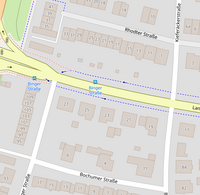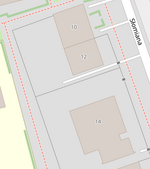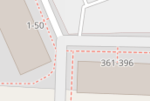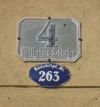Ko:Key:addr:*
(Redirected from Ko:Key:addr)
 |
| 설명 |
|---|
| 주소를 나타낼 때 쓰는 다양한 addr:* 키의 접두어 |
| 그룹: 주소 |
| 해당 요소의 사용 |
| 같이 보기 |
| 상태:사실상 표준 |
| taginfo: addr:* |
다양한 addr:*=* 키를 이용하면 건물이나 시설의 주소 정보를 나타낼 수 있습니다. 자세한 사용법은 Addresses를 참조하세요.
지도편집 방법
주소를 추가할 지점
주소 태그는 다음 위치에 추가합니다
- 관심 지점(POI)의 목표물



 ;
; - 주소가 목표물(즉, 단독주택, 단독 테라스 하우스, 학교 교정)에 전체적으로 유효할 경우의 영역
 (건물이나 교내/부지 윤곽)을 나타내는 다각형;
(건물이나 교내/부지 윤곽)을 나타내는 다각형; - 부지 윤곽선이나 건물 윤곽선상에 위치하는 특정노드
 (즉, 입구, 정문)혹은 특히, 몇개의 출입구를 가진 아파트 건물과 같이 오브젝트가 다중의 주소를 가질때, 그 지점에 해당되는 주소가 오브젝트에 포함되는 특정노드
(즉, 입구, 정문)혹은 특히, 몇개의 출입구를 가진 아파트 건물과 같이 오브젝트가 다중의 주소를 가질때, 그 지점에 해당되는 주소가 오브젝트에 포함되는 특정노드 ;
; - 주소의 범위를 모를경우의 노드

추가할 내용
최소한 아래 내용은 추가해 주세요
addr:housenumber=*(혹은 우편 주소의 일부일 경우addr:housename=*)addr:street=*
해당 목적물이 존재하며 정보를 알고있다면 아래 내용을 추가해주세요:
addr:city=*addr:postcode=*(단일 요소에 추가하는 것은 해당 지역의 지도편집 관례에 따릅니다)addr:country=*(당신 국가의 지도편집 관례에 따릅니다)
우편주소의 일부분이라면 아래 내용을 추가해주세요:
addr:suburb=*addr:state=*addr:province=*addr:floor=*
OSM Carto 형식 지도에 렌더링된 주소 예시:
addr:city=*과 같은 상위수준 태그들은 그들이 포함된 각각의 경계관계(경계선이 존재하고 유효하다면)로부터 계산될 수 있기 때문에 보통 불필요합니다.
addr:country=*태그 사용에 대한 관점은 국가별 커뮤니티마다 서로 다릅니다. 독일의 경우 태깅에 필수적인 부분으로 생각하는 반면 폴란드는 원치않는 태그로 간주합니다
주소 수집법
- 주소를 빠르게 수집하는 방법은 Rapid Address Collection 문서에 서술되어 있습니다.
- 한국 주소는 도로명주소 안내시스템(행정안전부)의 정보를 이용할 수 있습니다.
자주 사용하는 하위 키
| 키 | 값 | 요소 | 설명 | 렌더링 | 이미지 | |
|---|---|---|---|---|---|---|
Tags for individual houses | ||||||
| addr:housenumber | user defined | The house number (may contain letters, dashes or other characters). Addresses describes ways to tag a single building with multiple addresses. Please do not only tag addr:housenumber=*, but also add at least addr:street=* or addr:place=* for places without streets (or map the belonging to a street with a relation using associatedStreet relation or street relation.)
|

|
 | ||
| addr:housename | user defined | The name of a house. This is sometimes used in some countries like England, Spain, Portugal, Latvia instead of (or in addition to) a house number. |
 | |||
| addr:flats | user defined | The unit numbers (a range or a list) of the flats or apartments located behind a single entrance door. | 
|

| ||
| addr:conscriptionnumber | user defined | This special kind of housenumber relates to a settlement instead of a street. Conscription numbers were introduced in the Austro-Hungarian Empire and are still in use in some parts of Europe, sometimes together with street-related housenumbers which are also called orientation numbers. |  | |||
| addr:street | user defined | The name of the respective street. If the street name is very long or nonexistent, the ref of the respective street. A way with highway=* or a square with place=square and the corresponding name should be found nearby. The belonging to a street can alternatively be represented by a associatedStreet relation or street relation. The keys addr:housenumber=* and addr:street=* in principle are the only necessary ones if there are valid border polygons. If you are not sure if it is so, just add addr:city=*, addr:postcode=* and addr:country=*.
|
 | |||
| addr:place | user defined | This is part of an address which refers to the name of some territorial zone (usually a place=* like island, square or very small village) instead of a street (highway=*). Should not be used together with addr:street=*.
|
||||
| addr:postcode | user defined | The postal code of the building/area. Some mappers prefer to rely on boundary=postal_code
|
||||
| addr:city | user defined | The name of the city as given in postal addresses of the building/area. (In some places the city in the address corresponds to the post office that serves the area rather than the actual city, if any, in which the building is located.) Some mappers assume it can be derived from a boundary=administrative relation.
|
 | |||
| addr:country | user defined | The ISO 3166-1 alpha-2 two letter country code in upper case. Example: "DE" for Germany, "CH" for Switzerland, "AT" for Austria, "FR" for France, "IT" for Italy. Caveat: The ISO 3166-1 code for Great Britain is "GB" and not "UK". More or less favoured in different national communities. |
||||
| addr:postbox | user defined | Use this for addressing postal service Post Office Box (PO Box, BP - Boîte Postale, CP - Case Postale, Поштански преградак, Поштански фах, Поштански претинац) as alternative to addressing using street names. Example: "PO Box 34" | ||||
| addr:full | user defined | Use this for a full-text, often multi-line, address if you find the structured address fields unsuitable for denoting the address of this particular location. Examples: "Fifth house on the left after the village oak, Smalltown, Smallcountry", or addresses using special delivery names or codes (possibly via an unrelated city name and post code), or PO Boxes. Beware that these strings can hardly be parsed by software: "1200 West Sunset Boulevard Suite 110A" is still better represented as addr:housenumber=1200 + addr:street=West Sunset Boulevard + addr:unit=110A.
|
||||
For countries using hamlet, subdistrict, district, province, state, county | ||||||
| addr:hamlet | user defined | The hamlet of the object. In France, some addresses use hamlets instead of street names, use the generic addr:place=* instead.
|
 | |||
| addr:suburb | user defined | If an address exists several times in a city. You have to add the name of the settlement. See Australian definition of suburb. | ||||
| addr:subdistrict | user defined | The subdistrict of the object. | ||||
| addr:district | user defined | The district of the object. | ||||
| addr:province | user defined | The province of the object. For Canada, uppercase two-letter postal abbreviations (BC, AB, ON, QC, etc.) are used. In Russia a synonym {{{key:addr:region}}} is widely used | ||||
| addr:state | user defined | The state of the object. For the US, uppercase two-letter postal abbreviations (AK, CA, HI, NY, TX, WY, etc.) are used. | ||||
| addr:county | user defined | The county of the object. | ||||
Tags for interpolation ways | ||||||
| addr:interpolation | all/even/odd/ alphabetic | How to interpolate the house numbers belonging to the way along the respective street. See detailed description. |
 | |||
| addr:interpolation | Number n | Every nth house between the end nodes is represented by the interpolation way. | ||||
| addr:inclusion | actual/estimate/potential | Optional tag to indicate the accuracy level of survey used to create the address interpolation way. See detailed description. |
||||
This section is a wiki template with a default description in English. Editable here.
한국어 번역은 여기에 있습니다.
자세한 하위 키
더 자세한 정보는 Proposed features/addr keys (2011-04)을 참조하세요.
| 키 | 값 | 요소 | 비고 | 사진 | Taginfo |
|---|---|---|---|---|---|
| 건물의 일부분에 사용하는 태그 | |||||
| addr:door | 사용자 정의 | 아파트/연립주택/사무실/방 문의 번호 (혹은 이름). 일부 국가에서는 이와는 다른 명칭을 사용합니다(오스트리아에서는 "Top"이라고 함). 한 방에 문이 여러 개 있다면, 문마다 이 태그를 달아주면 됩니다. 같이 보기: room=*
|
|||
| addr:unit | 사용자 정의 | 대규모 단지 안에 속한 단일 건물, 혹은 복합 건물 안에 속한 단일 구역을 나타내는 숫자/문자/이름. 큰 건물 하나에 입구가 하나만 있더라도, 건물 내부 통로는 다양한 구역이나 계단으로 나눠질 수 있습니다. 이런 경우, 특정 아파트/건물/사무실은 특정 구역으로만 진입할 수 있습니다. 이 태그는 아파트, 스위트룸, 사무실의 번호를 나타내는 데 사용하기 좋습니다. 이러한 정보는 우체부들에게 유용합니다. | |||
| addr:floor | 숫자 | 아파트/건물/사무실이 위치한 층. 이 태그는 일반적으로 사용되지 않습니다. 대체재를 찾아보세요. 같이 보기: level=*
|
|||
| addr:block | 사용자 정의 | (주소로서) 도시의 블록. 이 태그는 수도 없이 쓰였지만, 이 태그의 널리 받아들여지는 해석은 존재하지 않습니다. |
| ||
다국어 주소
공용어가 여러 개인 지역에서는 주소 키 뒤에 언어 코드를 덧붙임으로써 주소를 현지화할 수 있습니다.
언어 코드를 선택하는 방법은 Multilingual_names를 참조하세요.
건물번호가 없는 주소
- 만일 주소에 건물번호가 없다면,
nohousenumber=yes태그를 붙이세요.
